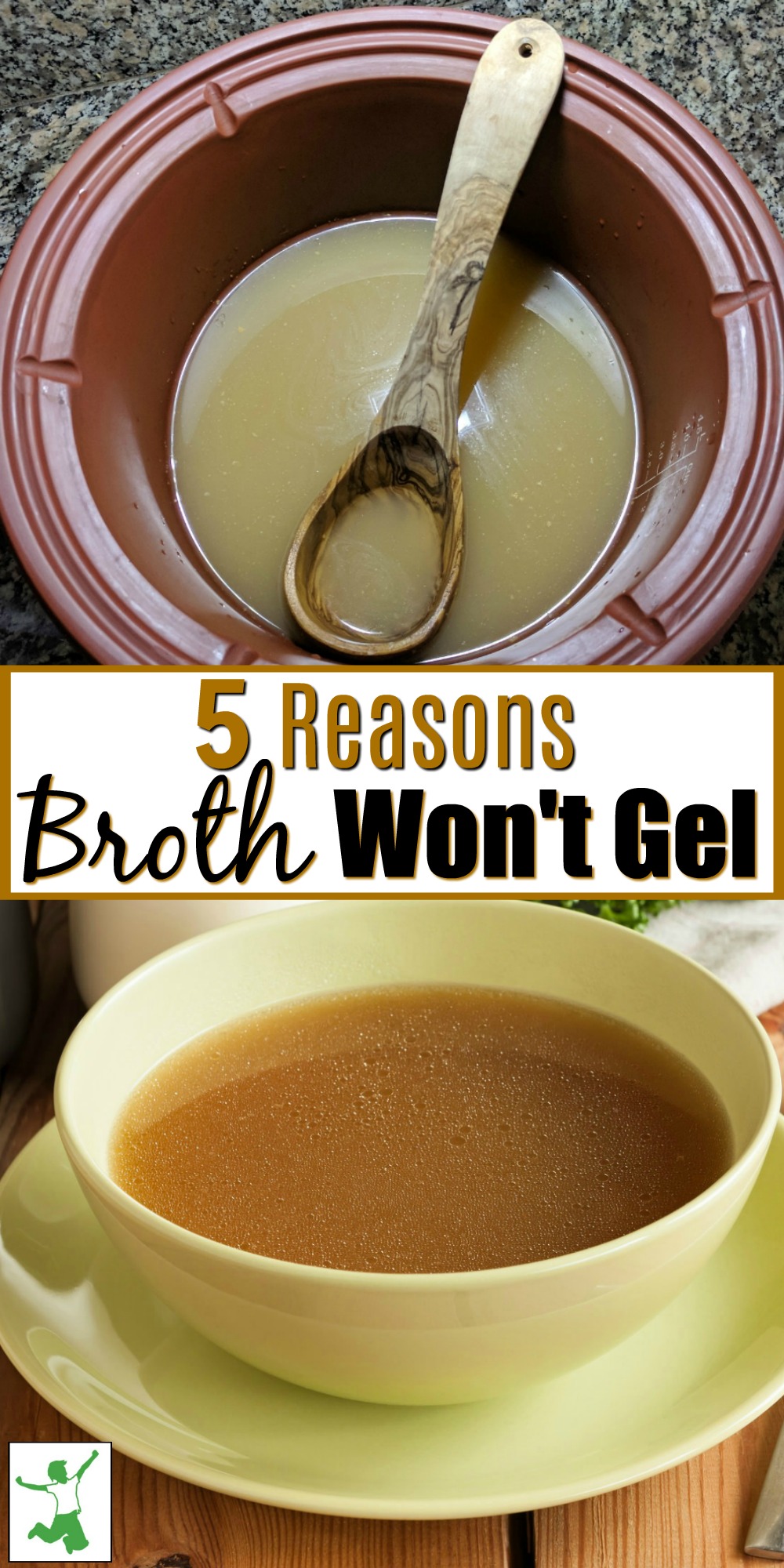
Do you have frequent trouble where your homemade broth doesn’t gel after being chilled in the refrigerator? This is a problem to solve quickly, as correct preparation is one of the foundational techniques of Traditional Cooking.
So critical is properly made, gelled homemade stock to the ongoing maintenance of health that Dr. Francis Pottenger MD, author of the nutrition classic Pottenger’s Cats, considered the stockpot the most important piece of equipment in the kitchen.
Homemade stock is so essential because it contains ample amounts of gelatin, a colloidal substance that attracts digestive juices to itself and prevents gastrointestinal bugs from attaching themselves to the gut wall and wreaking havoc. Natural gelatin both assists digestion and keeps you well!
In addition to gelatin, stock contains minerals such as calcium, silicon, sulphur, magnesium, phosphorus, and trace minerals all in a form that is incredibly easy for the body to absorb.
Do you take expensive supplements for joint pain or arthritis?
Simply adding homemade stock on a frequent basis to your diet will do your cartilage, tendons, and joints a world of good as stock also contains collagen, chondroitin sulfates, and glucosamine.
With homemade stock such a critical food to health, it is important to make it correctly. One sign that you have indeed performed the task well is that your stock gels beautifully once it is chilled in the refrigerator.
If you find that your stock won’t gel most of the time, here are the 5 typical reasons why as described by Monica Corrado, MA, CNC, and author of the blog Simply Being Well. Monica teaches cooking classes and does consultations, so be sure to check her website for this information if you could use some coaching.
Reasons Why Stock and Bone Broth Won’t Gel
- The stock rolled at too high a temperature. If stock or broth is simmered too high, the heat will break down and destroy the collagen. To see what the perfect simmer on your stock should look like, see my short video on the subject by clicking here.
- The stock did not roll long enough. Once you get that perfect simmer or “roll” going, be sure that chicken stock rolls for 6-24 hours and beef stock for 12-50 hours. Less than that will likely not draw enough gelatin into the stock from the bones.
- Not enough of the right kind of bones were used that yield gelatin. To get the right mix of bones that yield gelatin versus other types of bones that add flavor and color, make sure you use one of the following methods: 1 whole, free-range layer hen with neck and wings cut up, 3-4 lbs of boney chicken parts which includes a combo of necks, backs, and wings, OR the picked carcass of 2 meat chickens. For beef stock, use about 7 lbs bones total (4 lbs of boney bones and 3 lbs of meaty bones).
- Too much water was used in proportion to the bones. For chickens, the correct proportion is 3-4 lbs of bones per 4 quarts of filtered water. For beef stock, the correct proportion is 7 lbs of bones per 4 quarts of water or more to cover.
- Using bones from battery chickens or chickens raised in cages. Conventionally raised chickens or chickens raised in cages typically yield little to no gelatin. It is worth the extra money to get quality when you buy meat especially if you will be using those bones to make stock.
To get additional gelatin, add 2-4 chicken feet to the stockpot or even the head for even more! If your chicken is a rooster, add the comb. This will also add gelatin along with testosterone to the stock which adult men may find appealing as levels tend to decline with age.
Failsafe Solution If Your Stock Won’t Gel
If despite all your best efforts, you still come up with a pot of stock that does not gel, add 1 TBL of powdered gelatin per quart of liquid.
Vetted sources of good quality gelatin are available under the Supplements Section of my Shopping Guide.
Hopefully, these tips will help you solve the riddle of why your stock doesn’t gel so that the time you spend on this age-old culinary tradition is well spent producing the most nutrient-dense stock possible!

More Information about Gelatin
The Reason You Need More Gelatin in Your Diet
Gelatin and Collagen Hydrolysate: What’s the Difference?
The Benefits of Gelatin and How to Get More in Your Stock
Video: Stock that Gels!
More Information on Broth and Stock
How to Make Turkey Stock
The Healthiest and Best Bone Broth
How to Make Duck Stock
Rabbit Stock
How to Make Beef and Chicken Stock
How to Make Shrimp Stock
Confused about Stock versus Bone Broth?
The Perfect Simmer on Your Bone Broth








What a timely post. I have a big stockpot full of beef stock bubbling away on the stove right now. This is the first time that I’ve made it solo. I’ve always made it at cooking school under the watchful eye of a trained chef. I’m hoping it gels this time 🙂 I made chicken stock last weekend which turned out beautifully!
I put mine in the oven when we’re away or sleeping and it’s not done yet.
My stock doesn’t gel typically, I think I tend to use too much water. But the last batch I added in 3-4 chicken feet, which I found at a new asian store in town and it was more gelatinous!! Not rigid, but better than it has been. I think I just need to pay more attention to how much water I use.
My stock doesn’t gel because I do use a lot of water. One time when I made the stock in a much smaller stockpot, it did gel. My 7 year old daughter and I went through all of the stock in 2 days. We drink a LOT of broth. So I don’t necessarily mind that the stock isn’t gelled or else I’d be making stock every other day, yet have way too much chicken to be able to eat.
If you are making beef broth, throw in some calf’s feet 🙂 This is a gaurenteed gell-getting ingredient! I find them at the ethnic grocery in the stock bones section…
Thanks for the tips, Sarah!
I just found this blog…
Wow, I guess i took a lot for granted… my stock & soups always gelled… It never occurred to me that someone’s stock wouldn’t… I always use home grown, organically fed (grass fed), hand raised livestock for my meats, always boil the carcasses clean… all of the cartilage always intact, and the bones of the carcasses always dry virtually chalk white when I’m done. I know I have gotten everything I can out of them. I still have about 30 of my own chickens, 3 or my own turkeys, and just a little bit of my beef left in the freezer yet… I was raised on bone broths, and have been making this and many other traditional things by hand, since I was a little girl…
Hi Folks..
Good post Sara, but no where in the post did you explain what “Gel” means
I get a thick layer of gel and or fat on my stock but are you talking complete gel like stock jello or just really thick yet liquid broth?
Thanks
Brothman in training…
Tim
Hi Tim! 🙂
Check the video link in the first sentence of the post. A picture of gelled stock is shown. But, to answer your question with words, yes – all the stock liquid should turn jelly like after being cooled in the fridge.
Ok got it!!
Now I know what to shoot for.
Thanks as always.
Tim
My stock NEVER gelled. One time, after removing bones, meat and veggies, I left it on the stove to cool, but forgot to turn off the stove! By the time I remembered it, the two gallons had cooked down to two quarts of stock that gelled perfectly. Aha!
Thank you so much for this Sarah. I just went to a local farm and bought a freshly butchered pastured, organic fed happy chicken, the livers and the feet. I’m excited to make broth with the feet for the first time!
Excellent Kristi. Congratulations … learning to make traditional stock is a huge step toward learning how to maintain health with nutrition.
Linda,
In addition to its nutritional benefits, gelatin adds a ‘mouth feel’ or texture to the stock/broth, so it doesn’t seem like drinking water. The gelatin is not a distinct component of the stock, like say, the fat that rises to the top to be skimmed off. The fat can be skimmed and melted then filtered through cheesecloth a couple times for use in frying or baking.
I never skim off the fat from my stock. When made from properly raised animals, I feel it’s an important and delicious part of the total nutrition of the stock (and my trad food oriented doctor agrees).
I’m concerned about leaving anything cooking or simmering while out of the house or sleeping. Is this fear unfounded?
The heat for simmering stock is so very low when it is simmering correctly there is very little danger. I have another post to write about this as well. Some folks do it in a crockpot instead. I will try and write that this week 🙂
Whenever I don’t want to smell mine all night long, I turn the flame off just before I go to bed and wrap the stock pot with a thick towel. First thing in the morning, I turn the flame back on and the broth is simmering in 15 minutes. I’ve read that a lot of other people do this too and it works great. Maybe Sarah has some info on whether this is a good idea or not.
How do you use the gelatin from the stock? Reheat it or how ?
Thank you !
The gelatin is part of the stock and is not removed from it .. you use the stock to make soups and sauces.
Click on the recipes tab in the header of the blog and select “soups and sauces” from the pulldown menu for many recipes for using homemade stock.
Thank you Sarah. I’m an old farm wife and mom and I guess i just took stock geling for granted because mine always did and does . I just assumed it was part of cooking. So I thought maybe you all used it somehow differently! I boiled many many veggies in stock over the years. I am drinking the stock now as i did 13 days of the milk fast , would still be doing it but i ran out of milk . I’m going back on when it comes. I have never felt so good! And Thank the good Lord I almost always feel good! But in the mean time I wanted to put some good things into my body so did a chicken in the crock pot. It gelled(sp) beautifully.I never really thought of it NOT geling … 🙂